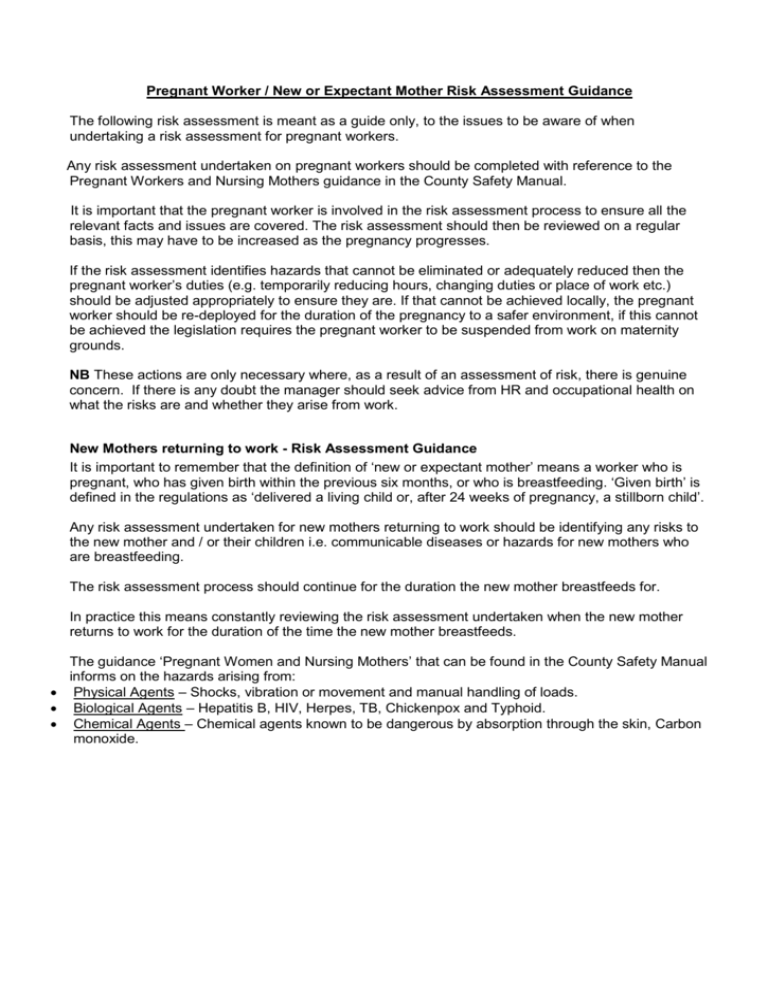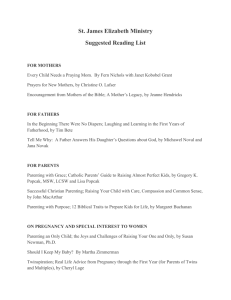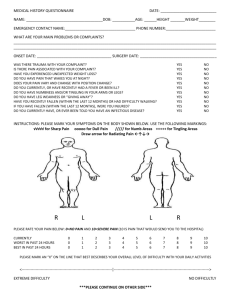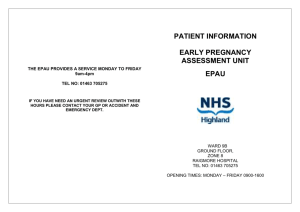Pregnant worker RISK ASSESSMENT
advertisement

Pregnant Worker / New or Expectant Mother Risk Assessment Guidance The following risk assessment is meant as a guide only, to the issues to be aware of when undertaking a risk assessment for pregnant workers. Any risk assessment undertaken on pregnant workers should be completed with reference to the Pregnant Workers and Nursing Mothers guidance in the County Safety Manual. It is important that the pregnant worker is involved in the risk assessment process to ensure all the relevant facts and issues are covered. The risk assessment should then be reviewed on a regular basis, this may have to be increased as the pregnancy progresses. If the risk assessment identifies hazards that cannot be eliminated or adequately reduced then the pregnant worker’s duties (e.g. temporarily reducing hours, changing duties or place of work etc.) should be adjusted appropriately to ensure they are. If that cannot be achieved locally, the pregnant worker should be re-deployed for the duration of the pregnancy to a safer environment, if this cannot be achieved the legislation requires the pregnant worker to be suspended from work on maternity grounds. NB These actions are only necessary where, as a result of an assessment of risk, there is genuine concern. If there is any doubt the manager should seek advice from HR and occupational health on what the risks are and whether they arise from work. New Mothers returning to work - Risk Assessment Guidance It is important to remember that the definition of ‘new or expectant mother’ means a worker who is pregnant, who has given birth within the previous six months, or who is breastfeeding. ‘Given birth’ is defined in the regulations as ‘delivered a living child or, after 24 weeks of pregnancy, a stillborn child’. Any risk assessment undertaken for new mothers returning to work should be identifying any risks to the new mother and / or their children i.e. communicable diseases or hazards for new mothers who are breastfeeding. The risk assessment process should continue for the duration the new mother breastfeeds for. In practice this means constantly reviewing the risk assessment undertaken when the new mother returns to work for the duration of the time the new mother breastfeeds. The guidance ‘Pregnant Women and Nursing Mothers’ that can be found in the County Safety Manual informs on the hazards arising from: Physical Agents – Shocks, vibration or movement and manual handling of loads. Biological Agents – Hepatitis B, HIV, Herpes, TB, Chickenpox and Typhoid. Chemical Agents – Chemical agents known to be dangerous by absorption through the skin, Carbon monoxide. RISK ASSESSMENT FOR: Pregnant worker Risk Assessment Establishment: Assessment by: Date: 1st Review Date Due : Manager Approval: Date: Description of activities: Describe tasks undertaken by employee. E.g. everyday duties include DSE and office work, external meetings with clients and driving to and from establishments Week’s pregnant (Approximately): The proposed date for maternity leave is …………… (or dependant on practicality of work). Baby Due (Approximately): Hazard / Risk Who is at Risk? How can the hazards cause harm? Normal Control Measures Are Normal Control Measures Y/N/NA In Place Effects of pregnancy that may occur Morning sickness / nausea, Backache, Varicose veins, Haemorrhoids, Frequent visits To the toilet, Balance, Comfort, Increasing body size, Tiredness,. Individuals past history History of miscarriage, high blood pressure hypertension Pregnant worker Unborn child Nausea / vomiting, Aches and pains, Bleeding, Restricted movement. Risk of stress, slips, trips and falls, tiredness Existing risk assessments. (For employed duties) GP / Midwife advice and treatment. Pregnant workers own knowledge, experience and training of employed duties. Miscarriage, Stress, medical complications. Hygiene facilities: There are sufficient toilets and associated hygiene facilities available. Adequate onsite arrangements for nutrition and liquid refreshments. Also that she is able to take breaks as and when required Facilities: - Adequate Resting facilities available (requirement under the regulations for employers to provide a quiet rest area to put feet up or lie down if required in the future.) Adequate Client group: Unpredictable / Challenging behaviour, Level of care needs Physical / verbal assault, Communicable disease infection, Miscarriage, Stress, Vulnerability Contact with known or potentially violent clients should be prevented wherever possible for duration of pregnancy. Employed duties: Consider if the following are significant Manual handling, Driving, Poor or Prolonged Working Postures, Lone working, Administration of medication, Night work, Shift work Physical injury, Vulnerability, Poisoning causing foetal lesions i.e. injury or disease to foetus, Tiredness, Stress, Miscarriage. No significant manual handling of loads to be undertaken for duration of pregnancy. Member of staff to request assistance / support available. Environment: Small / limited workspace, Exposure to excessive temperatures, lack of rest facilities. Exposure to hazardous substances, Body fluid spillages. Slips, trips and falls, Miscarriage, Fainting, foetal lesions, inability to take adequate breaks / rest, Communicable disease infection Mental / Physical fatigue and working hours: currently able to cope with her workload and working hours this will be reviewed with pregnant employee and manager as pregnancy develops. Display Screen Equipment (DSE): if a DSE user review DSE Risk Assessment on workstation. Working Alone: Provide adequate training and access to communications, mobile phone, personal alarms etc. Ensure support is available. If the risk cannot be significantly reduced offer alternative work Adequate resting facilities available Condition of premises regularly checked Prompt maintenance of defects Immediate cleaning up of spillages Good housekeeping maintained Exposure to Communicable Diseases: . Hepatitis B, TB, HIV, Chickenpox etc. For a more comprehensive list refer to the Pregnant Workers and Nursing Mothers guidance in the County Safety Manual Infection, foetal lesions, Miscarriage Awareness of HPA guidance on infection control in schools Good hygiene practice followed ( universal infection control procedures) Pregnant staff in direct contact with someone with a potentially infectious rash (e.g. chicken pox, measles, rubella etc.) to seek advice from their GP / midwife. All female staff under the age of 25 working with young children should have evidence of 2 doses of MMR vaccine. As Pregnancy is not a static condition and the nature and degree of risk will change as the pregnancy develops, risk assessment to be reviewed on a regular basis in agreement with the pregnant worker, or sooner if any significant change. Pregnant worker should inform Line Manager of any changes in their condition that may be relevant to their pregnancy and their safety at work. Additional Control Measures (to take account of local/individual circumstances including changes such as working practices, equipment, staffing levels). Action by Whom (list the name of the person/people who have been designated to conduct actions) Action by When (set timescales for the completion of the actions – remember to prioritise them) Action Completed (record the actual date of completion for each action listed) Residual Risk Rating DATE OF REVIEW: Record actual date of review COMMENTS: Record any comments reviewer wishes to make. Including recommendations for future reviews. DATE OF REVIEW: COMMENTS: DATE OF REVIEW: COMMENTS: RESIDUAL RISK RATING VERY HIGH (VH) Strong likelihood of fatality / serious injury occurring HIGH (H) Possibility of fatality/serious injury occurring MEDIUM (M) Possibility of significant injury or over 3 day absence occurring LOW (L) Possibility of minor injury only ACTION REQUIRED The activity must not take place at all. You must identify further controls to reduce the risk rating. You must identify further controls to reduce the risk rating. Seek further advice, e.g. from your H&S Team If it is not possible to lower risk further, you will need to consider the risk against the benefit. Monitor risk assessments at this rating more regularly and closely. No further action required.






